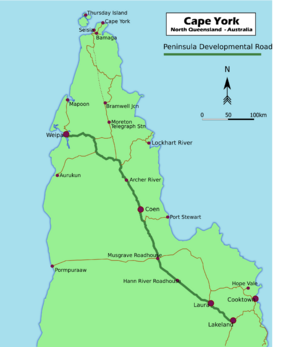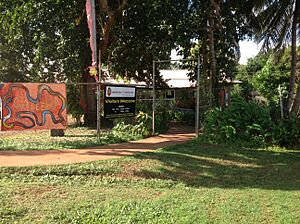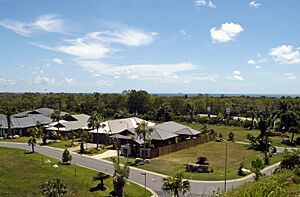Cape York Institute for Policy and Leadership facts for kids
| Abbreviation | CYI |
|---|---|
| Nickname | Cape York Institute |
| Formation | 2004 |
| Founder | Noel Pearson |
|
Region
|
Cape York Peninsula, Queensland, Australia |
|
Parent organization
|
Cape York Partnerships |
The Cape York Institute for Policy and Leadership, also known as the Cape York Institute, is an Australian organisation. It studies and puts into action plans to help people in Cape York. Its main goal is to reduce differences between Indigenous and non-Indigenous people. They focus on improving how welfare support is given out.
The Institute was started in July 2004 by Noel Pearson. He is a lawyer and a strong supporter of Indigenous welfare. The organisation works with the people of Cape York and Griffith University. It writes reports for the Australian Federal Government. These reports suggest ways to improve welfare and the economy. The aim is to help communities in Cape York thrive.
The Institute works with other groups like Cape York Partnerships. They also work with the Family Responsibilities Commission. The Cape York Institute gets money from the Australian and Queensland State Governments. This funding helps with projects in education, jobs, families, and housing for Indigenous people.
Contents
What is the Cape York Institute's Goal?
The main goal of 'The Cape York Agenda' is to give Aboriginal and Torres Strait Islander (ATSI) people more freedom. It aims to help them get involved in the "Real Economy." This means having jobs and earning money, instead of relying only on welfare. The "Real Economy" is a system that encourages people to manage their own opportunities.
The Institute wants more ATSI people to take part in the economy. They have programs that manage how welfare money is used. This helps people use their benefits responsibly. The Agenda wants Indigenous people to be independent from the welfare system. It also encourages home ownership, more jobs, and better school attendance. The main aim is to help Indigenous people feel in control of their lives. They want people to take responsibility, rather than just depending on welfare.
The "Hand Out to Hand Up" Plan
The Cape York Institute wrote a report called "Hand Out to Hand Up." This report explained how the Cape York Welfare Reform Project would work. The idea was to link welfare payments to certain responsibilities. The report suggested rebuilding community standards in Aurukun, Coen, Mossman Gorge, and Hope Vale. It focused on responsibility, education, jobs, and housing for individuals, families, and communities.
To help families and protect children, the report suggested creating the Family Responsibility Commission (FRC). The FRC would be an independent group. It would make sure people in Cape York communities used their welfare payments responsibly. This was done through special income management plans.
For jobs, the report suggested changes to the Community Development Employment Projects (CDEP). CDEP helped Aboriginal and Torres Strait Islander people find jobs. The report wanted the FRC to oversee CDEP payments. This would help people rely less on welfare. The report also wanted more access to ABSTUDY payments. This government program helps ATSI youth with education costs and living expenses for boarding school. To help Indigenous people own homes, the report suggested making rental agreements easier. It also proposed building affordable homes in rural areas. The "Pride of Place" program was planned to help with renting, home ownership, and renovations.
The Cape York Trial
After the "Hand Up to Hand Out" Report, the Australian and Queensland Governments supported a trial. They provided 96 million dollars from 2008 to 2012. The Cape York Institute and its partners ran this trial. It focused on four main areas where Indigenous people faced challenges: social responsibility, education, jobs, and housing.
Encouraging Responsibility
In 2008, the Institute started the Family Responsibilities Commission (FRC) with the Queensland Government. The FRC checks if people receiving welfare payments are meeting their responsibilities. The FRC gets information from government agencies. It steps in if a welfare recipient breaks a rule of their Income Management Scheme. This includes not following tenancy agreements or not protecting children.
The FRC holds meetings with community members. They decide if a person has followed their welfare rules. If agreements are broken, the FRC can add more conditions. They can also manage how a person's welfare money is spent. This "Conditional Income Management Scheme" means money can only be used for important things. This includes food, clothes, and medicine. This helps people use their welfare money wisely.
Improving Education
In 2011, the Cape York Institute helped create the Cape York Aboriginal Australian Academy (CYAAA). This was a new part of the Trial. In the last two years of the Trial, the CYAAA helped improve school attendance. They worked with parents, students, and teachers in the four trial communities.
The CYAAA also helped families plan budgets for school costs. This was done through Student Education Trusts (SETs). The ABSTUDY allowance was expanded. This allowed young people from Cape York to attend boarding schools outside their home communities.
Creating Job Opportunities
During the Institute's Trial, the Community Development Employment Projects (CDEP) scheme changed. People who were getting CDEP wages moved to Conditional Income Payments. The Institute and the Family Responsibilities Commission watched how they spent their money. Under this plan, CDEP workers were given full-time jobs.
More training and work placement programs were also started. This helped residents get better jobs and keep them. Business areas were set up in Aurukun and Hope Vale. These areas helped small businesses grow. The Cape York Institute worked with Mission Australia. They offered mentoring and skills training. This helped local businesses grow and encouraged graduates to join the workforce. It also increased participation in trade, engineering, and healthcare apprenticeships.
Better Housing Options
The Institute's trial created programs to make it easier for people to own or rent homes. Laws were changed to help people rent public homes from private landlords. The FRC used the Income Management Scheme to make sure people followed their rental agreements. If someone broke the agreement, they could face eviction or stricter money management.
To help people own homes, housing and land laws were changed. The Aboriginal and Torres Strait Islander Land Act 1991 (QLD) was updated. It allowed private residential leases for 99 years. This meant Indigenous residents could get money from their income providers to buy or build a home. The "Pride of Place Program" started in 2008. It renovated backyards of homes in the four communities. This program helped people feel proud of their homes.
How the Cape York Trial Worked Out
In 2013, the Department of Families, Housing, Community Services and Indigenous Affairs (FaHCSIA) reviewed the Cape York Trial. They looked at how well it worked to improve social responsibility, education, jobs, and housing.
At first, the FRC faced challenges. It was hard to manage staff and costs. There were delays in setting up meeting places. It was also difficult to find enough support services for people. These issues made it harder for the FRC to do its job. However, the FRC later expanded its support services. It helped about half of the adults in the four trial communities. This made it easier for the FRC to refer people to meetings and manage welfare resources. Surveys showed that 90% of people said they followed the agreements they made. The Queensland Government decided to continue the Income Management program until June 2019. The Australian Government extended it further until June 2021. The FRC still operates in Aurukun, Coen, Mossman Gorge, and Hope Vale.
The CYAAA was set up in Aurukun and Coen in 2010, and in Hope Vale in 2011. In its first three years, the CYAAA did not fully reach its goals for student attendance. Attendance improved in 2010 but slightly dropped in 2011 and 2012. After the trial, attendance in Aurukun and Hope Vale went back to pre-trial levels. However, there was progress in academic results. Students in schools that worked with CYAAA showed better scores in NAPLAN tests. This was true for students in years three to seven. The Coen Campus kept higher average results for longer than schools in Aurukun and Hope Vale. This trend continued after the trial ended.
In the job and housing areas, some programs did not fully continue after the Trial. Census data showed that the employment rate in all four communities increased. This was because 103 CDEP workers moved into full-time jobs. Also, 118 new service jobs were created. However, building business areas in Coen and Aurukun was delayed. Community leaders did not approve the first plans. This slowed down job growth. In Mossman Gorge and Hope Vale, new business areas led to more jobs. Employment levels increased by 20.3% and 23.4% from 2006 to 2011.
For housing, the Trial created 442 rental agreements. The Pride of Place Program built 32 new houses and renovated 197 homes. However, the goal of helping people buy their own homes was not fully met. No properties were bought in Aurukun, Hope Vale, and Mossman Gorge during the Trial. The Pride of Place Program is still running today. It continues to renovate homes in the Cape York region. In 2013, the Australian Government gave 2.7 million dollars. This money helped build sewerage, water, and electricity systems. This encouraged more people to consider buying homes.
Images for kids





